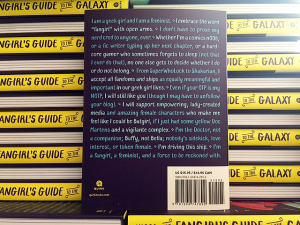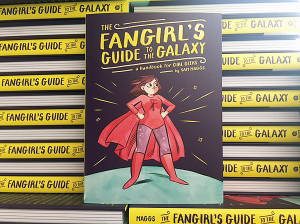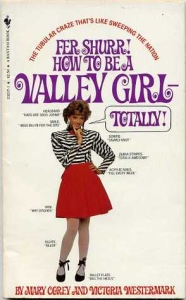THE FANGIRL’S GUIDE TO THE GALAXY
BY SAM MAGGS
PUBLISHED BY QUIRK BOOKS
AMBER LOVE 28-MAR-2015 If you’re in the mood for a fun, fast read on a weekend when you have nothing to do, THE FANGIRL’S GUIDE TO THE GALAXY is like enjoying a popcorn movie – one that doesn’t require a ton of critical analysis, but satisfies your craving for entertainment. Author Sam Maggs presents a conversational collection of advice almost in a “Dear Sam†style as if the readers have questions about niche elements of fandom. From cosplay to convention going, Maggs tackles a massive subject by focusing on a select few, but very key, elements about being a female fan in 2015’s pop culture. I have few criticisms which aren’t major and nothing that could prevent readers from cruising through the pages with ease. Full disclosure, I’m pretty sure I met Maggs at New York Comic Con 2014 at The Mary Sue lounge.

Right off the bat, with chapter one, Maggs sets the tone for the guidebook. She has a perpetual pep squad cheer. She starts by welcoming new fans and paying respects to those who pioneered the fan space for the things they love.
I squeed (yes, occasionally even I fall into fangirl speak just as I did my Valley Girl days), when Maggs included one of my favorite things in her chapter on noteworthy fandoms. I’m the consummate outsider – the one who doesn’t like DOCTOR WHO, GAME OF THRONES or MASS EFFECT. They just aren’t things I care about. So when Maggs threw one of my favorite shows, PSYCH, into the mix of notable fandoms, my grinchy heart grew. PSYCH-Os, unite!
Maggs took the various fandoms and presented them like an Audubon wildlife guide. It was clever and kept the pace quick. She had some examples of how to show off your love for something in every day clique-style-secret-code fashion. For example if you’re wearing a time turner necklace or Aragorn’s ring, there’s a chance someone else “in the know†might see it and start up conversation. It’s like the Freemasonry secrets for geeks. And from there you can have a delightful conversation about whether Professor Snape is a darling romantic or a super creepy stalker.
The lexicon of fangirl dialect showed some terrific research about terminology thought of as modern inventions by teen girls which are really lingo from over a hundred years ago. As I referenced Valley Girl speak before, the FANGIRLS’ GUIDE is a modern take on a book I read in the 80’s, FER SHURR! HOW TO BE A VALLEY GIRL – TOTALLY! The best twist is that Maggs (probably not even aware of what Valley Girls are) didn’t write about how one should do x, y, or z to fit in, but rather presented the advice in a encouraging way to be more you than some trendy someone else.
In the chapter on lingo, Maggs included fun things like what “shipping†and “OTP†mean; she also laid down some serious tips about trigger warnings, content warnings and the reasons fans want them.
Another tip I wholeheartedly second is that if you go into a comic shop, game shop, or a convention booth and a sales person treats you as less than a real fan, take your business elsewhere – and don’t be afraid to tweet or yelp what happened.
Between the chapters are interviews with some of pop culture’s notable women including writers, performers, actors and cartoonists. What’s interesting is that only one, Erica Schultz who happens to be a friend of mine, said that she dislikes the moniker “fangirl†because it’s often used to derisively. Nearly every interviewee answered the last question the same way. Maggs asked what advice they would give to fangirls. It was as if they were reciting the answer: never apologize for loving the things you love and showing your fan appreciation.
ONLINE LIFE
The social networks portion of the guide has some great tips about the pros of sites like Twitter, tumblr, etc. I wish Maggs would have included some deeper technical merits about the platforms. I, for one, opt for Pinterest over Instagram because IG’s upload function only works from a mobile device and it forces image cropping. There’s no way to post without having an image from your phone and that’s a huge setback, in my opinion. So I’m off on the uncool, old lady scrapbook favorite, Pinterest – not that Maggs described it that way at all; it’s the general awareness I get of the youth market online. Instagram and Vine beat YouTube and Pinterest despite the latter choices being better technical products.
Maggs also gives great cautionary advice about what to do as a new user of the networks. For Twitter, change that default egg avatar immediately. No one will talk to you if you don’t because it’s the sign of an account that is sock puppet for someone else. I’d give the same warning to any “hot girl†avatar with tweets about products – it’s just a sales bot. Maggs lays down some important etiquette which is the sort of thing that one can lecture about all day long and still know that people who are rude are going to stay rude. As for tumblr, I disagree with Maggs calling it a “microblogging†tool because it does all for full length blog entries and plenty of people are using it for their official sites and foregoing the complexity of WordPress.
Another warning that Maggs tries to drill home is about something that I am profoundly sensitive about. I am a person, not the voicebox for a corporation. Therefore my online presence is completely made up of moments of self expression. Maggs warns in a way that sounds like she’s addressing a rather young reader, that posting things today may prevent you from getting a job or possibly even land you into trouble. All true. Unfortunately. It’s why I don’t like to have coworkers following or friending me until I’m done at a company.
TROLLS
The chapter on online trolls is hilariously presented. Maggs came up with different species of internet trolls from lightweights up to the epic Troll Boss. I was a bit shocked, at first, that she included “white knights†– guys who come to the defense of women being harassed online. Sounds good to me. In fact, I encourage that. However, the important distinction to a white knight actually being a troll is when a guy is nice and supportive only as a means to an end. The end being getting laid. If you tell a fake nice guy to back off and that you can handle your own fight, you might get the backlash of, “you’re a cunt/bitch and I was only kidding I’d never help an uggo like you.â€
CONVENTIONS
A lot of geeks will appreciate the chapter on surviving a convention. If you’ve never been, take this part seriously. If you are a veteran, you’ll read through it like I did and nod at each paragraph with an affirmative “uh huh†about the downsides to cons. The con crud and post-con depression are real things that happen all the time. A friend of mine, Tom Feister, coined the term “connui†to refer to the sinking loneliness and sudden crash of energy after a con. It sucks that when you get back from your con trip, you probably need a week off because you’ll be sick as a dog.
COSPLAY
The cosplay chapter is a decent layout of some basic reasons why you’d want to get into a costume. It’s not a “how to†and there a tons of books and blogs about that anyway. It’s a section that encourages fans who have never cosplayed before to give it a try.
FEMINISM
This is the only F-word in the guide that might wrinkle feathers. The thing is, I suspect the target demographic for FANGIRLS’ GUIDE is already well aware of what feminism is and doesn’t need these chapters. There’s a wonderful mini lexicon like in the fangirl speak section. It explains modern feminism terms like “mansplaining†and “male gaze.†Maggs also made clear efforts in this section and throughout the book to be inclusive of gender, sexual orientations, and ethnic differences.
There’s a section that busts common myths of feminism. Again, I think it’s preaching to the choir. The people who are reading this book already know these things. These sections belong in a FANBOYS GUIDE. Like I said, Maggs writes as if she’s having a conversation or public speaking to women, and refers to the readers with rallying cries like “come on, ladies!†The best reason for including these portions in a guidebook for women is that it may give someone the perfect rebuttal they might not have thought of on their own.
THE RECOMMENDATIONS
Since I was reviewing a galley I expected formatting issues and typos. However, I did find a legitimate mistake in a fact. The RED SONJA: QUEEN OF PLAGUES volume in the comic recommendations section was published by Dynamite Entertainment not Image Comics. Red Sonja is a character that has been published by several different houses so this was an easy mistake to make.
I also take a bit of an issue with recommending RAT QUEENS so blanketly without acknowledging the elephant in the room. I also recommend the series, but I’ve come out and spoken about co-creator Roc Upchurch’s sordid history as an abuser who beat his wife. He’s off the book now, so that’s good. But I think in a chapter where an author is recommending great feminist tales, this was a serious omission. It’s not that Maggs was afraid of the subject either because she specifically mentioned how Sir Patrick Stewart speaks out against domestic violence.
The book, TV, and game recommendations weren’t particularly inclusive either. It’s great that so many women find sanctuary in the pages of YA fantasy, but honestly, there’s an awful lot more out there than dragons and vampires and future post-apocalyptic hackers. There’s a big world outside of speculative fiction and you wouldn’t know it based on Maggs’ recommendations. I know it’s unlikely to see cosplay of Miss Marple, but don’t think it won’t be on my own To-Do list in a few years. The recommendations felt stifling and exclusionary. I might own elf ears (true story) but I also would love to cosplay or just be immersed in badass female characters like Fish Mooney and Cookie Lyons. I felt like the suggestions were too restrictive, not that they were bad recommendations.
REFERENCES AND RESOURCES
Maggs lists all sorts of online resources for blogs, news, and shopping. Of the ones that I have any familiarity with, I can say the clothing resources are also quite exclusionary. I would recommend removing sites that don’t offer any sizes considered average or above. If offerings are limited to women only of thin body types, they aren’t what I consider welcoming and aren’t a good resource for new fangirls to explore.
 OVERALL:
OVERALL:
4.5 stars! I had a great time reading this book and was able to cruise through it in a couple of days. Fast readers could probably do it in one.



